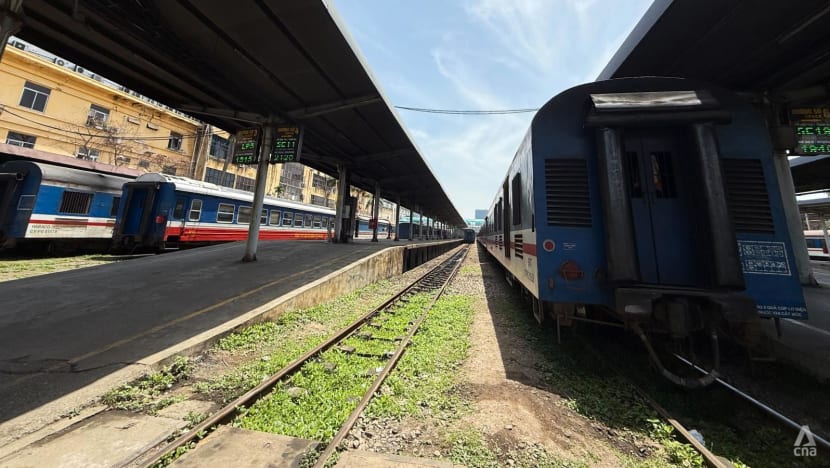Vietnam seeks development and balance in game-changing cross-border rail links with China
Both countries launched a new railway cooperation mechanism during a visit by Chinese President Xi Jinping to Hanoi last month, with the goal of aligning their respective railway gauges.

A banner on a train in Vietnamese and Chinese, welcomes passengers onboard the "Vietnam-China friendship train", at Hanoi's railway station.

This audio is generated by an AI tool.
HANOI: Chatter filled the platform as 67-year-old Mr Ma Ronghong’s tour group boarded their waiting train at Hanoi’s railway station.
An unmissable red and white banner hung outside one of the carriages, warmly welcoming the passengers onboard the “Vietnam-China friendship train”.
“Neighbours are great, better than distant relatives,” said Mr Ma, who is visiting Vietnam for the first time.
The retiree, who hails from China’s Chengdu city, was on a 12-day tour through Vietnam by train and bus, setting off from Nanning in southern China's Guangxi province.

Currently, passengers and goods must swap trains at the border because the ageing Vietnamese railway gauge is incompatible with China’s high-speed railway.
"To be honest, the transportation (in Vietnam) and its level of development now is not as good and cannot compare with China’s,” said Mr Ma, who added he did not mind the longer journey.
"But if they improve this last mile, it will definitely be a win-win for everyone.”
This could become a reality, with new cross-border rail links between China and Vietnam on the cards.
These projects are set to be a game changer for Hanoi, with increased trade and tourism expected between the two countries.
“I think travellers won’t feel as tired from the journey anymore. If the two countries’ railways are directly connected, it’ll be much easier and more convenient to come to Vietnam and enjoy its beautiful scenery,” said tour guide Mr Zhou Jianwei.
He added this would mean greater ease in handling its large groups, which go up to 300 participants each time.
The Chinese tour agency that Mr Zhou works for began running such rail tours a year ago, and it has seen growing interest from Chinese tourists.
It has since increased the tour's frequency from once a month to about five times a month.
Tour packages cost less than US$400, which the agency says is a cheaper alternative to flying for visitors looking to visit multiple cities in a single trip.
"There won’t be all those issues like changing trains or clearing customs - it’ll all be much simpler and more convenient,” added Mr Zhou, who expressed hope for the cross-border service to start soon.
SIMPLIFYING CONNECTIONS
China and Vietnam have long discussed collaboration on three railway projects.
Both countries launched a new railway cooperation mechanism during a visit by Chinese President Xi Jinping to Hanoi last month, with the goal of aligning their railway gauges.

An agreement to conduct feasibility studies for two of these projects was also inked, while a third railway line is set to begin construction in 2025.
That 403km-long passenger and freight line is expected to connect Kunming in China’s south, to Lao Cai at the border in Vietnam. It will then run through the capital Hanoi to reach Hai Phong on Vietnam’s northern coast, where a key international port is located.
Reports say the new line is expected to include 18 stations and trains will be able to travel at top speeds of 160kmh.
The US$8 billion project, which is to be partially funded through Chinese loans, is an upgrade for Vietnam’s ageing railway infrastructure that dates to French colonial times.
"If I go to China, I often go by car, so (if there is a train link with China), I will choose the train when I go on trips or travel with friends, so that I can experience more of other public transportation modes,” said 28-year-old freelancer Mr Vi Dinh Tian.
"I think that the train linking from Hanoi to China is also a very interesting experience in the future,” he added.
"This will be very convenient for trade. Hai Phong has a very large port, so (the new train link) will shorten a lot of travel time from Hai Phong straight to Lao Cai, instead of transiting through Hanoi,” added 37-year-old driver Mr Le Minh Quan.
Vietnam’s top leader To Lam said building the three railways was the “highest priority” in infrastructure cooperation between the two sides and called on China to offer concessional loans.

"The prioritised goals of Vietnamese leaders at the moment is to enhance its economic development and to diversify away from any single partner, which is the United States,” said Dr Nguyen Khac Giang, visiting fellow at the ISEAS-Yusof Ishak Institute.
He added railway projects would improve cooperation on the economic and trade fronts with China, as Beijing has been keen to show its support for neighbours in the face of sweeping global US tariffs.
China has been on a charm offensive seeking deeper cooperation with its trading partners, especially in Southeast Asia in the face of its trade war with the US.
CAUTIOUS COOPERATION
However, Dr Nguyen pointed out that the bilateral agreements announced during President Xi’s visit have been limited to cross-border projects.
"The rationale is that, because it's connecting Vietnam and China, so China should be a prioritised partner in financing and in providing the know-how,” said Dr Nguyen.
The agreements did not involve Vietnam’s larger north-south high-speed railway project, set to link Hanoi in the north with Ho Chi Minh City in the south in around six hours.
He added that if there are any delays with the project, this would be limited to just one area in north Vietnam.
This comes as Vietnam seeks to hedge against China, preventing any potential spillover implications of Chinese financing or investment.
"The north-south (high-speed railway) project is very important and is connecting, basically the whole length of Vietnam,” said Dr Nguyen.
"So it would need to be considered much more in terms of security and defence as well.”
















